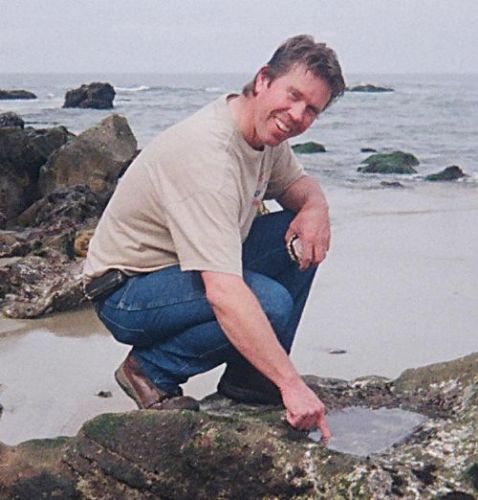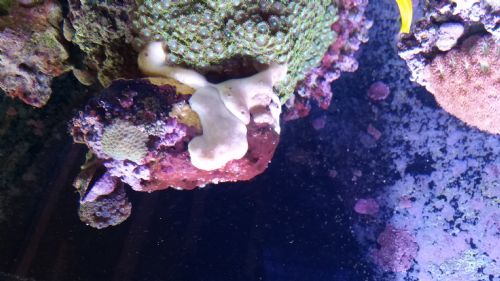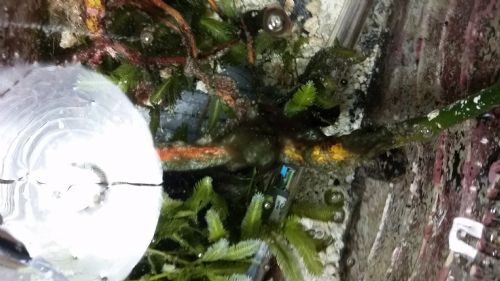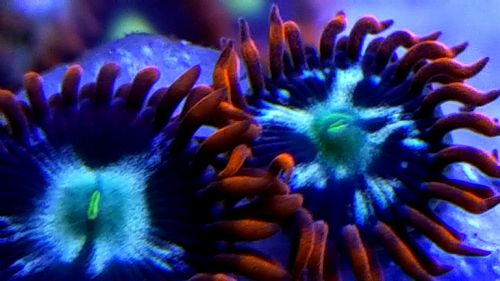| Author |
 Topic Search Topic Search  Topic Options Topic Options
|
omj 
Guest


Joined: February 15 2014
Location: West Jordan
Status: Offline
Points: 98
|
 Post Options Post Options
 Thanks(0) Thanks(0)
 Quote Quote  Reply Reply
 Topic: Marine Pure and/or Bio-pellets Topic: Marine Pure and/or Bio-pellets
Posted: January 16 2016 at 6:45pm |
|
Have been working on nitrate removal, I added GFO a few months ago and found great results at phosphate removal, however I still have issues with some hair algae so I am looking to target nitrates. I have been following the BRS180 and they recently did a video that touched on Marine Pure as a nitrate removal (at least for the 8x8x4 blocks) and have considered that as an option. But I have also been considering the bio-pellets in place of the GFO.
Who has experience with Marine Pure? I'm not opposed to removing some of my live rock or just adding a block (the 8x8x4 brick) of MP to my sump to see if it affects the nitrates, but if it is primarily just an ammonia, nitrites removal vehicle it's useless to me, my live rock is doing the trick for my setup...
bio-pellets are targeting nitrates, so that interests me, but it's an ongoing expense, along with GFO and I plan on using the GFO reactor to run bio-pellets, so I can't use both. Unless I buy another reactor dedicated to the bio-pellets. If I am running bio-pellets, I shouldn't need to run GFO, correct?
Overall, (the crux of the message is) nitrate removal, what is the best method?
Edited by omj - January 16 2016 at 6:47pm
|
|
That's what she said!
|
 |
Marcoss 
Guest


Joined: November 23 2014
Location: American Fork
Status: Offline
Points: 1277
|
 Post Options Post Options
 Thanks(0) Thanks(0)
 Quote Quote  Reply Reply
 Posted: January 16 2016 at 6:51pm Posted: January 16 2016 at 6:51pm |
|
I love and use MarinePure products and they work great, however they are not intended to remove nitrates, per se. They act as a super porous material, which is like live rock. Having the extra surface area to grow bacteria is what removes the nitrates. It's just like having that much more rock work in a super small package. If your expectations are that it is like live rock, well dead rock, you'll love them. I use them in my systems so I can limit the amount of live rock. I still used live rock to get things going.
|
|
RedSea Max S400 - 90G Rimless Frag Tanks x2 - 185 Lookdown Bin
|
 |
Baccara 
Guest


Joined: September 12 2014
Location: Sandy, UT
Status: Offline
Points: 66
|
 Post Options Post Options
 Thanks(0) Thanks(0)
 Quote Quote  Reply Reply
 Posted: January 16 2016 at 7:43pm Posted: January 16 2016 at 7:43pm |
|
I have always had success with carbon dosing. Spend some time researching it and take it slow. It very cheap and effective.
|
|
210g Display in progress
|
 |
Fatman 
Guest


Joined: December 23 2011
Location: South Weber, UT
Status: Offline
Points: 1694
|
 Post Options Post Options
 Thanks(0) Thanks(0)
 Quote Quote  Reply Reply
 Posted: January 16 2016 at 9:59pm Posted: January 16 2016 at 9:59pm |
|
I like carbon dosing too. I use vinegar. The carbon fuels the bacteria that consumes the nitrates and dies off. It's important to skim to remove the dead bacteria or you'll get the nitrates released back info the system.
|
 |
phys 
Guest


Joined: March 04 2011
Location: Capitol Hill
Status: Offline
Points: 1982
|
 Post Options Post Options
 Thanks(0) Thanks(0)
 Quote Quote  Reply Reply
 Posted: January 17 2016 at 4:27am Posted: January 17 2016 at 4:27am |
|
Whats the source of the nitrates? Nip it at the bud.
|
 |
Mark Peterson 
Paid Member


Joined: June 19 2002
Location: Murray
Status: Offline
Points: 21436
|
 Post Options Post Options
 Thanks(0) Thanks(0)
 Quote Quote  Reply Reply
 Posted: January 17 2016 at 8:57am Posted: January 17 2016 at 8:57am |
I agree with Paul/phys. Look at the chemical reactions going on in the system, then find and eliminate the root cause. If NH4 and NO2 are low but NO3 is higher, like above ~20 ppm there is something in the system that is creating more NO3 than can be effectively processed by the biofiltration. Nitrate is the last molecule in the chain of processes we affectionately call the Nitrogen Cycle.

Some of the products/equipment sold in this industry, when placed in a reef system actually become what we call a "Nitrate Factory", places where Nitrates are overproduced. External and HOB filters are two examples. Bioballs and dirty filter socks are two more. When used in freshwater aquariums these items are great filtration, but in marine systems they become Nitrate Factories. Is there a Nitrate Factory in the system 
Just out of curiosity, what is the level of Nitrate we're talking about 
Notice in the simplified illustration above that Nitrate is processed/eaten by plants & algae. This is the basis of all life on earth. Without the action of Chlorophyll in plants, the earth would soon die. In addition to photosynthesis, there is another process that breaks down Nitrate. It's carried out by the bacteria living in the lower depths of LS and the inside of every piece of good porous LR. Bacteria that live in the absence of Oxygen will use NO3 as a source of food and Oxygen. This is why I am always talking about the benefit that comes from good mature LR and LS. Are the LR and LS full of life(bacteria, bugs, worms) or instead are they too clean and barren  Is there a sand sifting fish living in(disturbing) the LS bed 
If there has been a recurring issue with Cyanobacteria in this system, the biofiltration processes discussed above will also help eliminate that nuisance.  Yea, no more need to buy Red Slime Remover.
Aloha, Mark 
|
Reefkeeping Tips, & quick, easy setup tricks:www.utahreefs.com/forum/forum_posts.asp?TID=9244 Pay it forward - become a paid WMAS member 
|
 |
omj 
Guest


Joined: February 15 2014
Location: West Jordan
Status: Offline
Points: 98
|
 Post Options Post Options
 Thanks(0) Thanks(0)
 Quote Quote  Reply Reply
 Posted: January 18 2016 at 6:23pm Posted: January 18 2016 at 6:23pm |
I haven't tested for Nitrates, I know there is an issue because of the undesirables that have been rearing their nasty heads. Here are two examples: Although the photo is upside down, it wasn't on my end, there is a re-occuring problem area, the cyano is there now, it has been hair algae, my snail mowed that down and now it's cyano, there is also some bubble algae in there. This isn't the only place I have issues, but probably the biggest.  The other area is in my sump, this dark greenish blue slime has been coating my macro and mangroves (sorry for the light reflections), it's bad enough it creates an oil slick inside the sump.  Aside from those I have a breakout of pink cotton candy algae in the sump, just need to get a turbo to knock that out. I clean my skimmer regularly, the longest the cup goes without a cleaning is a few days. A few months ago I took it out, cleaned it inside and out including the pump, but it didn't help. My tank is a 125 gallon unit, my skimmer is rated to 150 gallons, it might be pushing it with the water volume where the sump is included, but I'm not livestock heavy at all. My Phosphates are kept in check with the GFO/carbon mix, that I was hoping would clean up these issues, but alas, here I am still dealing with it. I do use filter socks, I change them out weekly, wash them in the clothes washer with extra rinse cycles to clean out any residual soaps or chlorine that might have gotten in the washer before I put them in. No bioballs, or external/HOB filters I try to limit what might become a nitrate factory when I am considering additions. Since I have been using the filter socks it seems like there have been less pods and brittle stars in the sump/fuge area, which I would expect with less food particles making it to them, the bristle worms haven't suffered though. What else?
|
|
That's what she said!
|
 |
Mark Peterson 
Paid Member


Joined: June 19 2002
Location: Murray
Status: Offline
Points: 21436
|
 Post Options Post Options
 Thanks(0) Thanks(0)
 Quote Quote  Reply Reply
 Posted: January 18 2016 at 7:08pm Posted: January 18 2016 at 7:08pm |
Thanks for the pics. I can tell you with absolute certainty that N pollution is within acceptable levels. How do I know that? I can tell by the look of the rock and coral, the Refugium algae and the dark greenish blue Cyanobacteria growing in the Refugium. Cyanobacteria used to be known as blue-green algae. I don't mind Cyano growing in the Refugium. Better there than in the display. Besides, that's one of the purposes of a Refugium - to grow algae, including Cyano, for harvest to remove nutrients from the system. The reason for the maroon Cyano on the top of that rock is because the rock has been turned upside down. The living organisms that were growing just fine on the underside in low light, are now in intense light and faster water flow. They died and are putting off pollution. An opportunistic organism and one of the oldest and toughest organisms on earth, Cyanobacteria has taken up residence. How do I know this? Simple.  White Sponge does not typically grow(or last for very long) on the top of rocks in bright light.
I don't know how you will react to this, since the purpose of this thread was to decide which bio-carbon dosing media to use to reduce Nitrate. Okay, so I'm not saying not to, but it looks to me like the real question here is how to eliminate the Cyanobacteria. There are some simple easy ways that don't cost a cent. If you have ever looked at the Reefkeeping Tips thread, what I have copied below may look familiar:
Red Slime/Cyanobacteria of many colors, how to eradicate it:
Aloha, Mark 
P.S. Everyone should familiarize themselves with the Reefkeeping Tips. The compilation of previous discussions found there resolves most of the issues that hobbyists come across. 
Edited by Mark Peterson - January 19 2016 at 2:36am
|
Reefkeeping Tips, & quick, easy setup tricks:www.utahreefs.com/forum/forum_posts.asp?TID=9244 Pay it forward - become a paid WMAS member 
|
 |
Mark Peterson 
Paid Member


Joined: June 19 2002
Location: Murray
Status: Offline
Points: 21436
|
 Post Options Post Options
 Thanks(0) Thanks(0)
 Quote Quote  Reply Reply
 Posted: January 18 2016 at 7:14pm Posted: January 18 2016 at 7:14pm |
* Yes, I'm saying that Nitrate is near enough to zero. Test it and find out for yourself.
Aloha, Mark  |
Reefkeeping Tips, & quick, easy setup tricks:www.utahreefs.com/forum/forum_posts.asp?TID=9244 Pay it forward - become a paid WMAS member 
|
 |
omj 
Guest


Joined: February 15 2014
Location: West Jordan
Status: Offline
Points: 98
|
 Post Options Post Options
 Thanks(0) Thanks(0)
 Quote Quote  Reply Reply
 Posted: January 18 2016 at 7:43pm Posted: January 18 2016 at 7:43pm |
Thanks Mark, I have had that rock for more than 2 years, it has always been that side up. That sponge started on the bottom and has been growing up the side into the light rather than further under the rock away from the rock:  The fuge area is a high flow area, that surprises me that it's cyano. It even grows on the return pump filter (rigid filter, not a sponge filter), where there is quite a bit of flow. I'm familiar with the causes and have cut back feedings to reduce the nitrates and phosphates. I like the idea of the marine pure as I want to remove some of the LR in the DT when it gets established, but the bio-pellets are something I need to think about. Should I ditch the filter socks? Thanks again!
|
|
That's what she said!
|
 |
phys 
Guest


Joined: March 04 2011
Location: Capitol Hill
Status: Offline
Points: 1982
|
 Post Options Post Options
 Thanks(0) Thanks(0)
 Quote Quote  Reply Reply
 Posted: January 18 2016 at 8:44pm Posted: January 18 2016 at 8:44pm |
|
Change the socks out sooner. Every couple days. How old is the light on your refug? If its too old then it might support the cyano growing faster than your other stuff. Do you have a fair amount of detritus in you tank or refugium? Enough that maybe you want to clean it out? If there is a lot of that in your tank, it'll be a constant supply of nitrates and phosphates.
|
 |
Reefer4Ever 
Guest


Joined: May 18 2014
Location: South Weber
Status: Offline
Points: 1120
|
 Post Options Post Options
 Thanks(0) Thanks(0)
 Quote Quote  Reply Reply
 Posted: January 18 2016 at 8:59pm Posted: January 18 2016 at 8:59pm |
|
Agree with changing out socks every 3 days.
|
|
90 gal reef w/refugium
24 gal softie tank
11 gal nano anemone tank
5 gal fresh water
|
 |
omj 
Guest


Joined: February 15 2014
Location: West Jordan
Status: Offline
Points: 98
|
 Post Options Post Options
 Thanks(0) Thanks(0)
 Quote Quote  Reply Reply
 Posted: January 18 2016 at 9:17pm Posted: January 18 2016 at 9:17pm |
|
Last week I turned up the sand and saw a layer of "darker sand" settle down on things, so that could be detritus build up, not enough clean up crew in the sump I guess. Over the weekend I cleaned out as much as I could in preparation for the marine pure block, so that could be some of the root cause.
I will add a few filter socks to the shopping list so I can change them out more frequently.
Thanks for the feedback peeps!
|
|
That's what she said!
|
 |
Mark Peterson 
Paid Member


Joined: June 19 2002
Location: Murray
Status: Offline
Points: 21436
|
 Post Options Post Options
 Thanks(0) Thanks(0)
 Quote Quote  Reply Reply
 Posted: January 18 2016 at 11:21pm Posted: January 18 2016 at 11:21pm |
 omj wrote: omj wrote:
Overall, (the crux of the message is) nitrate removal, what is the best method? |
I must say, if that is the crux of the message, then it's odd that the Nitrate level in this tank remains untested/unknown.
I'm sorry, I was wrong about the rock. There's the possibility of that pretty white Sponge taking over and killing something in/on that part of the rock, leading to extra pollution coming from that spot. Sponge is notorious for invading and killing off other organisms.
Sounds like more information about this tank could help.
What sand was "turned over" that showed black? (black sand is not bad, btw) What size and how deep is the sand? How long has the sand remained undisturbed? Full tank pic please? What kind and wattage are the lights for the display? Lights for the Refugium(reflection looks like a twist PC)? How long since a bulb change? What kind and how much fish food is going in to this tank?
A deep bed of LS in the Refugium is better than any other filtration medium, IMO. It does more good than a porous block. Think of the total surface area for beneficial bacteria, bugs and worms to thrive. Also, the ceramic block will end up being a Nitrate Factory. I don't use much LR in Refugiums. I generally use all available space for a DSB and Macroalgae. I use the brightest daylight color, twist PC lights possible. Algae grows faster with brighter light and we want the algae to grow as fast as possible.
Did you know that at the bottom of a deep sand bed Oxygen deprived bacteria break apart Nitrates into Nitrogen gas and water? In concert with algae, they are the final and best part of the N Cycle; the final breaking down of waste into non harmful molecules. In my tanks I go one step further and increase the sand surface area by using a layer of Oolitic Sand on the bottom (I haves tons of the stuff  ). It takes less Oolitic to do a better job than twice as much larger particle sand. I suggest reading the Reefkeeping Tip about Red Slime/Cyanobacteria. Many hobbyists have reported that adding just a few quarts of Oolitic Sand under their existing sand bed made Cyano disappear. ). It takes less Oolitic to do a better job than twice as much larger particle sand. I suggest reading the Reefkeeping Tip about Red Slime/Cyanobacteria. Many hobbyists have reported that adding just a few quarts of Oolitic Sand under their existing sand bed made Cyano disappear.
Aloha, Mark 
P.S. It's about the biology, not the equipment.
Edited by Mark Peterson - January 19 2016 at 2:44am
|
Reefkeeping Tips, & quick, easy setup tricks:www.utahreefs.com/forum/forum_posts.asp?TID=9244 Pay it forward - become a paid WMAS member 
|
 |
Mark Peterson 
Paid Member


Joined: June 19 2002
Location: Murray
Status: Offline
Points: 21436
|
 Post Options Post Options
 Thanks(0) Thanks(0)
 Quote Quote  Reply Reply
 Posted: January 19 2016 at 3:14am Posted: January 19 2016 at 3:14am |
 omj wrote: omj wrote:
bio-pellets are targeting nitrates, so that interests me, but it's an ongoing expense, along with GFO and I plan on using the GFO reactor to run bio-pellets, so I can't use both. Unless I buy another reactor dedicated to the bio-pellets. If I am running bio-pellets, I shouldn't need to run GFO, correct?
|
Biopellets have been a problem for some hobbyists. As far as I'm concerned, biopellets are just another gimmick that has already come and gone like so many other gimmicks.
Carbon dosing is as simple as feeding good quality natural foods that bacteria can use for fuel. IMO, dry processed foods are not acceptable for this purpose. I feed several types of frozen meaty foods, provide algae for the herbivores and supplement with single celled algae paste and some nighttime feedings of a good micron size dry processed food called Golden Pearls. I believe this procedure provides the same benefits as carbon dosing with alcohol, sugar or vinegar.
With a little help from us, Mother Nature can handle all the needs of a reef tank. In a natural, low cost system, there are just two artificial media that must be used, and only periodically, not continuously: 1. Activated Carbon 2. Phosphate removal media, either Activated Alumina (my preference) or Granulated Ferric Oxide
These media are so irreplaceable, they must be used even when a skimmer or macroalgae is used in the system.
Aloha, Mark 
|
Reefkeeping Tips, & quick, easy setup tricks:www.utahreefs.com/forum/forum_posts.asp?TID=9244 Pay it forward - become a paid WMAS member 
|
 |
omj 
Guest


Joined: February 15 2014
Location: West Jordan
Status: Offline
Points: 98
|
 Post Options Post Options
 Thanks(0) Thanks(0)
 Quote Quote  Reply Reply
 Posted: January 19 2016 at 11:42am Posted: January 19 2016 at 11:42am |
 Mark Peterson wrote: Mark Peterson wrote:
Also, the ceramic block will end up being a Nitrate Factory. |
Ok, so my live rock is a nitrate producer by nature of the biological filtration, however I envision the tern nitrate factory as something that has collected the wastes and byproducts of the livestock and stored them to become decaying matter>Ammonia>Nitrites>Nitrates, much like my filter socks that need to be changed out more frequently. I don't think it's fair to call a Ceramic Block or Live rock a nitrate factory. Also, Mark I wasn't attacking you with the rock being upside down, just pointing out that may not be the correct assumption. No harm intended! I understand the biology of the tank, like everyone I have had my ups and downs. I understand how LR and LS work within the tank. Marine Pure and Bio-Pellets interest me for what their manufactures claim it can do, so I asked who has experience with Marine Pure and if it affected their tanks as far as Nitrate removal, it sounds like carbon dosing with Vodka or vinegar will achieve the same results as the bio-pellets to help remove Nitrates. In summary, the Marine Pure will act as a live rock, for my scenario I can use that to remove some of the LR from my tank which is something that I have wanted to do for a while, but I shouldn't expect it to help remove nitrates from the tank. Carbon dosing is a tried and true method of nitrate removal, I have read up on Vodka dosing and will likely use that method to bring the nitrates down, but before I do that I must go back to testing nitrates to determine my start point. Thank you all for your feedback.
|
|
That's what she said!
|
 |
Mark Peterson 
Paid Member


Joined: June 19 2002
Location: Murray
Status: Offline
Points: 21436
|
 Post Options Post Options
 Thanks(0) Thanks(0)
 Quote Quote  Reply Reply
 Posted: January 19 2016 at 7:04pm Posted: January 19 2016 at 7:04pm |
I didn't feel attacked. I just moved on to the next plausible explanation for the Cyano in that spot. A forum does not give opportunity to ask quick questions and receive immediate answers so I often make assumptions hoping that I've hit it on the head.
I'm sorry if I gave the idea that LR produces Nitrates. That is definitely not true and it is not what I meant. The center of LR is similar to the low Oxygen bottom layer of LS. There is where Nitrate is converted into Nitrogen gas and water.
The Nitrate Factory, as we use the term, is not a place where crud/detritus is collecting. It is a place where well oxygenated water is flowing over and past the solid surfaces of the media such as, bioballs, an overflowing floss bag, a ceramic module, a biowheel, etc. The bacteria in this environment convert Ammonia into Nitrite and also convert Nitrite into Nitrate. Essentially, 2/3 of the N Cycle gets done, but the last 1/3 gets missed. The Nitrate level in such a tank is artificially elevated (40-80ppm) and within a week of the Nitrate Factory item being removed, the Nitrate level drops to <20 ppm.
I must be crazy. I don't even know why I'm bothering with this. I've said that, based on the pics, I believe the Nitrate level is within the acceptable range anyway. Because we still don't know what the actual Nitrate level is, we won't know what, if any, effect the ceramic block has on the system. It sure would be good to test the Nitrate now. 
Aloha, Mark 
Edited by Mark Peterson - January 19 2016 at 7:10pm
|
Reefkeeping Tips, & quick, easy setup tricks:www.utahreefs.com/forum/forum_posts.asp?TID=9244 Pay it forward - become a paid WMAS member 
|
 |
Mark Peterson 
Paid Member


Joined: June 19 2002
Location: Murray
Status: Offline
Points: 21436
|
 Post Options Post Options
 Thanks(0) Thanks(0)
 Quote Quote  Reply Reply
 Posted: January 21 2016 at 6:25am Posted: January 21 2016 at 6:25am |
Speaking of bio-pellets, the two articles linked in the thread below are along the lines of this topic. They are well worth reading.
Aloha, Mark  |
Reefkeeping Tips, & quick, easy setup tricks:www.utahreefs.com/forum/forum_posts.asp?TID=9244 Pay it forward - become a paid WMAS member 
|
 |